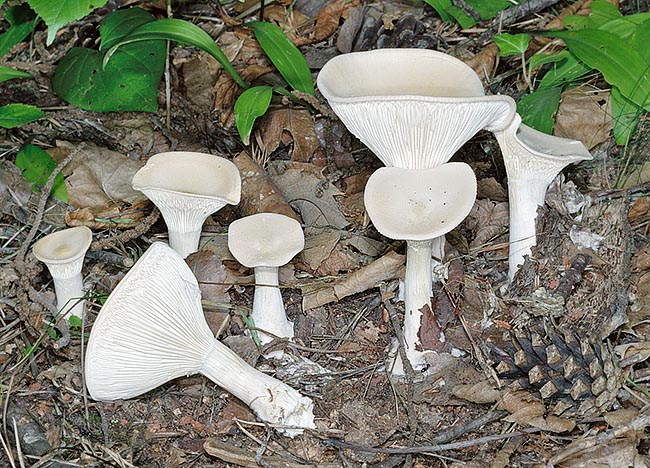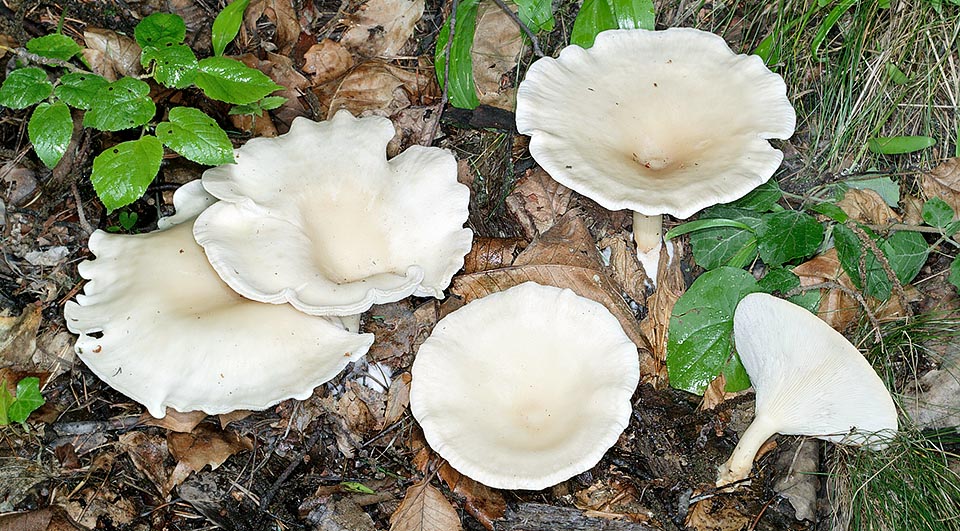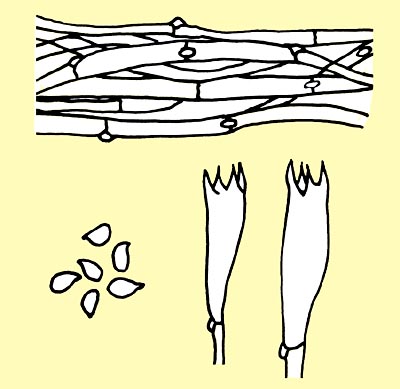
Text © Pierluigi Angeli

English translation by Mario Beltramini

Very common, when young Clitocybe gibba has a typical umbonate shape © Giuseppe Mazza
Family: Tricholomataceae R. Heim ex Pouzar (1983).
Genus: Clitocybe (E.M. Fries) Staude 1857.
Subgenus: Clitocybe.
Section: Clitocybe.
Clitocybe gibba (Persoon) P. Kummer 1871.
The term “gibba” comes from the Latin “gibbus” , meaning “hump, protuberance”, due to the umbonate shape the cap has when young.
It is a much common species and, in some places, is collected and also appreciated, but not everywhere.
The result is that few are the comon names : in Italy is called “ imbutino” ; in France is known as “Clitocybe en entonnoir” ; in Spain as “Seta en embudo” , in Germany as “Ockerbrauner Trichterling” , and in USA as “ Common funnel cap” .
Description of the genus
Please refer to the text on the Clitocybe nebularis.
To the subgenus Clitocybe belong fungi with the cap neatly funnel-shaped, with opaque surface, sub-velvety, at times scaly at the disk ; the colour is pale, whitish to brownish-red, rarely grey. The gills are neatly decurrent on the stem. Cylindroid stem, but sometimes also slightly enlarged a the base, fibrous, run by longitudinal fibrillae ; the colour varies from whitish to concolorous to the cap ; elastic flesh. Spores ellipsoidal to larmiform, pileipellis formed by tangled hyphae with parietal more or less zebra-like pigment.
To the section Clitocybe belong fungi with glabrous surface of the cap, or felted to more or less fibrillose-scaly, whitish flesh with cyanic odor. Larmiform spores and pigment of ther hyphae of the pileipellis always encrusting.

The 3-8 cm of diametre cap becomes later on more funnel-shaped. Only this is discreetly edible, as the stem, much fibtous, cannot be eaten © Giuseppe Mazza
Description of the species
Cap : 3-8 cm of diametre, convex flat to depressed, finally funnel-shaped, with a small umbo at the centre lasting long time, margin initially inrolled then straight, not hygrophanous, not streaked per transparency, at times can be slightly ribbed ; glabrous surface, finely felted, pale brown, pale ochraceous, alutaceous pale reddish, opaque.
Hymenium : thick gills, with entire thread, neatly decurrent on the stem, arcuate, spaced by several lamellulae of various breadth ; white or whitish, sometimes with pink shades.
Stem : 3-5 × 0,4-0,7 cm, cylindroid, clavate, fibrillose, full then fistulose ; smooth, with whitish longitudinal fibrillae on pale ochraceous bottom, base covered by whitish felting.

Pileipellis, spores and basidia © Pierluigi Angeli
Flesh : soft, little thick, elastic in the cap, fibrous in the stem, white ; the odor is typically cyanic, pleasant, mild flavour.
Habitat : Clitocybe gibba grows in groups even numerous on the litter of conifers as well as of broadleaf trees, in summer and autumn.
Edibility : discreet edible, appreciated in some zones ; only the cap is eaten being the stem somewhat fibrous.
Microscopy : ellipsoidal spores, 5,7-7,5 × 4-4,8 µm. Clavate basidia, tetrasporic, with joint buckles, 23-30 × 5-6,7 µm. Cystidia not observed. Pileipellis formed by horizontal and interlaced hyphae, with joint buckles, parietal pigment slightly brownish.
Remarks : this is a very common species growing abundantly after the summer and autumn rains. Well recognizable due to its peculiar characters : the funnel-shaped cap, the yellowish ochraceous, brownish yellow colour, the whitish gills, decurrent, the stem sub-concolor to the cap or whitish and the typical cyanic odor.
However, there are other species in the genus Clitocybe sharing the colour as well as the morphology. Clitocybe alkaliviolascens Bellù, distinguishes for the ochraceous brown cap, the stem that is concolorous to the cap and especially the reaction to the violet of the flesh with the KOH; Clitocybe costata Kühner & Romagnesi, distinguishes for the margin of the cap typically ribbed, sinuate-lobate, the ocher-brownish, the stem concolorous to the cap with coarse longitudinal fibrillae; Clitocybe squamulosa (Persoon : E.M. Fries) P. Kummer, distinguishes for the cap with fine scales and more reddish colours; Clitocybe sinopica (E.M. Fries) P. Kummer, distinguishes for a more fleshy cap of fawnish ocher colour and farinaceous odour. It may be also mistaken with Lepista flaccida (Sowerby) Patouillard, which, however, has fawnish-orange cap, pink-orange, the margin always inrolled, the decurrent gills neatly detaching, without breakage, the flesh of the cap and the spores appearing finely warty.
Synonyms : Agaricus gibbus Persoon 1801 (basionym); Omphalia gibba (Persoon) S.F. Gray 1821; Clitocybe infundibuliformis f. gibba (Persoon) P.A. Saccardo 1887; Clitocybe membranacea (Vahl) P.A. Saccardo 1887; Clitocybe infundibuliformis var. membranacea (Vahl) Massee 1893; Infundibulicybe gibba (Persoon) Harmaja 2003.
→ For general notions about Fungi please click here.
→ To appreciate the biodiversity of MUSHROOMS please click here.
